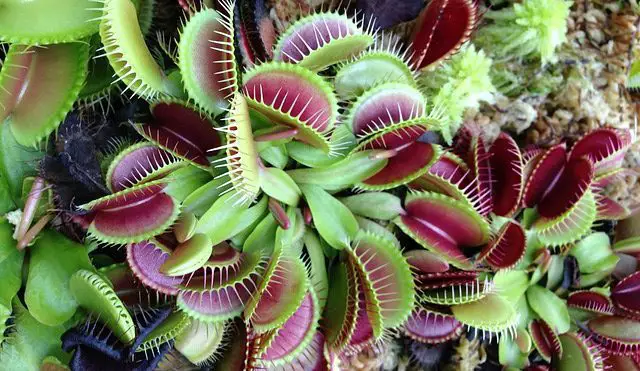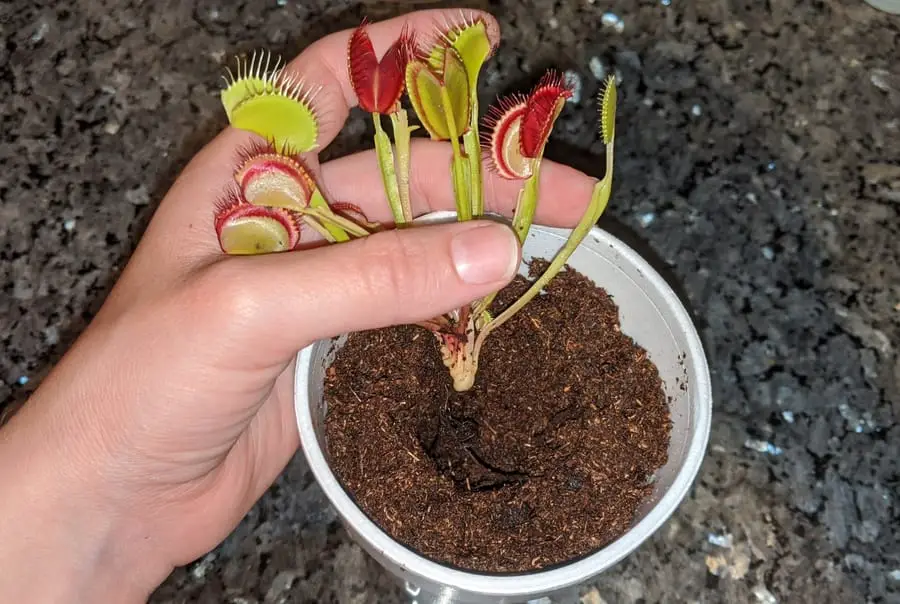Employing the wrong water for a Venus flytrap is a common mistake. If you have used tap water for your Venus flytrap, do not over stress. By acting quickly and following some simple steps, you can save your plant.
You can save a Venus flytrap after it has received tap water by draining the excess water, employing the correct water source, or repotting. Depending on the plant’s state, you can consider an aggressive approach such as repotting or just switching water types.
Employing tap water for your Venus flytrap can kill the plant. Follow the instructions below to save your plant.
Why is Tap Water Harmful to Venus Flytraps?
In their natural habitat, Venus flytraps have little to no exposure to nutrients from the ground or water. Such an environment led them to develop a carnivorous nature to supplement their diet by consuming insects. It has also made them intolerant to high concentrations of minerals or other nutrients, such as fertilizers.
Water for Venus flytraps must be pure. The presence of any additive can be harmful. For that reason, most tap water is unsuitable. Tap water contains dissolved solids that are harmless to most plants, but unsuitable for Venus flytraps.
Tap water quality can vary through different areas. In some locations, tap water is pure and contains less than 50 parts per million (ppm). Such tap water would work for Venus flytrap. However, it is not recommended to employ tap water unless you know its composition.
It is possible to measure the ppm in the tap water at your home by employing a Total Dissolved Solids (TDS) meter. You can buy one online for less than $15 (link to some examples on Amazon.com ). If you employ a TDS meter and the measurement is below 50 ppm, you can employ it for Venus Flytraps. In any other case, do not employ tap water.
). If you employ a TDS meter and the measurement is below 50 ppm, you can employ it for Venus Flytraps. In any other case, do not employ tap water.
Minerals in tap water accumulate in the carnivorous plant soil. Tap water does not kill Venus flytraps immediately, but it weakens them and creates yellow leaves. Eventually, Venus flytraps can die from drinking tap water.
Since tap water is almost always unsuitable for Venus flytrap, it is best to employ any of these three pure water sources:
- Distilled water
- Reverse osmosis water
- Rainwater
Ensure your plant stays healthy by employing the correct water.

Step by Step Guide: Save a Venus Flytrap After Watering With Tap Water
If you have used tap water for your Venus flytrap, follow the steps in this section to save your plant.
Assess the Damage on Your Plant
Some Venus flytraps are more resilient towards dissolved solids in tap water. Depending on the size, age, variety, and state of a Venus flytrap, your plant might respond differently to tap water. In this section, you must determine the state of your plant.
When assessing the damage, remember that black leaves are not necessarily a sign of poor health. It is normal to have a couple of dried up leaves every now and then. Still, if a plant is losing leaves without growing new ones, it a discouraging sign. Yellow leaves are a common sign of unhealthy conditions. Yellow leaves arise from mineral burns (due to employing tap water, for example)
Now, you must to classify your Venus flytrap into one of these categories:
- No Changes: You have used tap water for your plant but haven’t observed any differences yet. The plant is still healthy. It exhibits healthy leaves and new growth.
- Minor Damage: The plant looks down lightly, either by having one or two yellow leaves.
- Medium Damage: The plant exhibits multiple yellow leaves.
- Major Damage: Almost all leaves are compromised. You are afraid the plant might run out of traps.
Do your best to determine the state of your plant based on the categories. If you are in between two categories, I recommend selecting the one with greater damage to be safe.
Implement the Action Plan to Save Your Venus Flytrap
Depending on the state of your plant, there are different action steps you can take. Read the step-by-step guide that matches the observed damage in your Venus flytrap, and follow the instructions carefully.
Your Venus Flytrap Exhibits No Changes:
You used tap water for your Venus flytraps. And even though it is not recommended, your plant appears to be fine. Right now, you can’t notice any damage. That is great news!
If you are in this category, you do not need to do much, focus on these two items:
- Go to the grocery store and buy distilled water (you can also use reverse osmosis water or rainwater, but they are harder to obtain)
- Drain any excess water from your plant. If there is any water in the plant tray, toss it.
- Water your plant only with distilled water from now on.
- Continue to monitor in the next weeks. If it starts exhibiting some minor damage, follow the actions steps for minor damage (next section)
- Read the last section of this article and make sure you are taking good care of your plant during the recovery process
Your Venus Flytrap Exhibits Some Minor Damage
It is a good sign that a Venus flytrap only exhibits minor damages. You do not need to take an aggressive approach. Still, it critical that you complete the following steps:
- Extract as much water as possible: Let your plant drain any excess water by tossing any water in the tray and squeezing the pot lightly (if possible).
- Buy distilled water or obtain reverse osmosis water or rainwater.
- Water your Venus flytrap from the top until water comes out of the drainage hole. Repeat this process a few times to drain some of the old water and potentially clean up the soil from mineral buildup.
- Continue to water with pure water; avoid tap water at all costs.
- Continue to monitor in the next weeks. If the plant gets worst, follow the actions steps for medium to major damage (below)
- Read the very last section of this article. And make sure you are providing the best care to accelerate the recovery process.
Code Red: Medium to Major Damage on Venus Flytrap
Unfortunately, your plant is not looking very good at this time. But there is hope. Venus flytraps are resilient plants; they can recover from unsuitable growing conditions. You will need an aggressive approach to save your plant: you will repot the plant in new soil. Also, you will need the following items:
- Carnivorous plant soil (This article
 can help learn where to buy this special soil or how to DIY)
can help learn where to buy this special soil or how to DIY) - Pure water (distilled, reverse osmosis, or rainwater)
Now, follow these instructions to repot your plant:
- Remove your Venus flytrap from its pot and soil.
- Use pure water to clean the roots of the plant and remove all the soil.
- Toss the old soil away
- Add fresh new soil to the plant pot. It you need to upsize or change your pot, this guide has recommendations
 .
. - Pot your Venus flytrap in the new soil
- Water the plant with pure water until the soil is humid all around.
- Continue to care for the plant and monitor its health. You should observe new growth within the next 1-2 weeks. New leaves spurring out is a great sign!
- Follow the care advice in the last section to accelerate the healing process.

Potting and repotting a Venus flytrap can be a delicate process. If you have never done this before, I recommend reading this guide: Venus Flytrap Repotting Guide . It has pictures and instructions to ensure the repotting goes smoothly.
. It has pictures and instructions to ensure the repotting goes smoothly.
Care During Venus Flytrap Health Recovery Process
You have taken the necessary steps to save your Venus flytrap. Now, it is time to be patient and wait for your plant to get better.
I do not recommend making any major changes during the recovery process besides the ones you already implemented. Still, this care advice can help you increase the chances of recovery
- Avoid feeding the plant: Let your plant focus on healing rather than capturing bugs.
- Do not fertilize: Do not attempt to fertilize to speed up the process. Fertilizers can also kill Venus flytraps.
- Continue to water as usual: Make sure the soil is always moist. Venus flytraps thrive in humid environments.
- Trim dead leaves: Consider trimming any dead leaves to encourage growth.
- Do not play with the leaves and avoid any extra stress.
- Always use carnivorous plant soil: Here is a guide that lists the best soil options
 .
.
Making mistakes when growing Venus flytraps is normal. Carnivorous plants have particular needs! To ensure your plant remains healthy, I recommend downloading the Venus flytrap care sheet. You can download it from this article: Ultimate Venus Flytrap Care Guide .
.
Also, if you grow Venus flytraps indoors, this growing guide can help you perfect your setup: Venus  Fly Trap Indoor Guide
Fly Trap Indoor Guide .
.
